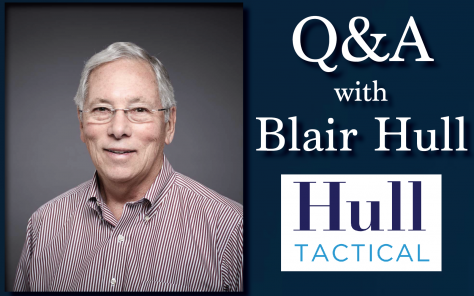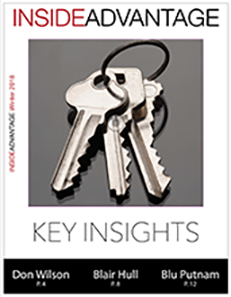
Blair Hull, Hull Tactical
Blair Hull is the founder of Hull Investments, LLC. In this interview with high volume futures trading broker, Advantage Futures, Blair talks about what led him to start his company, his interest in blackjack and the investment strategy at Hull Tactical.
DISCLAIMER: This article is presented for information purposes only. It is intended for your personal, non-commercial use. No information or opinions contained in this publication constitute a solicitation or offer to buy or sell securities, futures or to furnish any investment advice or service. PAST PERFORMANCE IS NOT NECESSARILY INDICATIVE OF FUTURE RESULTS. FUTURES INVESTMENT INVOLVES RISK AND IS NOT SUITABLE FOR ALL INVESTORS.
Advantage Futures: Please tell us about your early days in Los Gatos, California. What experiences were formative in you becoming a successful trader?
Mr. Blair Hull: My grandfather traded stocks, and I remember watching him chart these stocks every day using high, low and close. I had no idea what he was doing, but I was hooked. As an undergraduate at University of California Santa Barbara and later in business school, I was still trying to figure out what he was doing. I concluded, for the most part, charting wasn’t of much value; however, it piqued my interest in the investment process. Blackjack was really what got me into the investment world. Ed Thorp wrote a book in which he said if you had a lot of low cards out of the deck, then you had more big cards (10s, face cards and aces). If you got a Blackjack, you were paid one and a half to one, so you had an advantage. I played Blackjack for five years, 50 days a year.
William Sharpe, a Nobel Prize winner in economics, defined an investment as a sacrifice of current consumption for expected future gain. Gambling is just a sacrifice of current consumption for expected future loss. If you can actually turn the odds in your favor, you’re an investor. I was really an investor when I played Blackjack. The difficulty with Blackjack and investing is that you need to be in it for the long run. You must have enough individual investments that can prove out over an extended period of time. Investing and Blackjack are very uncertain games. One must play the game to gain the advantage, but one must also be able to stay in the game.
ADV: Tell us about your trading background and experience.
BH: I used the capital I earned as a Blackjack player to lease a seat on the Pacific Stock Exchange. I started trading options with the same theory of gaining the advantage and staying in the game but, in this case, coming up with a value of each option. Around the same time, I was intrigued by market timing. In 1981, I presented a paper at a gambling conference in Lake Tahoe concluding it was possible to time the market. Shortly after, I decided not to focus on market timing—one of my greatest decisions—because the returns from options trading, like Blackjack, vastly exceeded those of market timing. Instead, I concentrated on buying inexpensive options and selling expensive options. I built Hull Trading on this principle, and it eventually led to the sale of the firm to Goldman Sachs.
In 2008, I had a family office managing the proceeds of this sale. Like many other investors, we suffered substantial losses. Coming out of 2008, academic literature on market timing was turning. Articles previously claimed it was not possible to time the market, but a growing number of indicators were deemed to be predictive. I thought if I could put those into a strategy, I could potentially get enhanced returns; thus the formation of Hull Tactical and the strategy we have in place today.
ADV: What about Hull Tactical Asset Allocation appeals to your investors? What do you believe gives your firm a competitive edge?
BH: I believe it is the combination of a quantitative investment approach and intellectual transparency. The approach is rooted in capturing and combining into an “ensemble” an array of signals spanning statistical, behavioral/sentimental, technical, fundamental and economic data sources. The key is to combine a number of variables with a little bit of information in a sensible way and use this information to trade in a disciplined manner. Our strategy attempts to forecast the returns on the S&P 500 index by utilizing a wide variety of machine learning and statistical modeling tools. I also feel Hull Tactical’s transparency is unique. We published research papers about two of our models, one in Journal of Portfolio Management and one on SSRN (Social Science Research Network). We have a third paper in the works. These three papers combined will span about 75% of our current strategy. Hull Tactical also publishes a daily report showing how we arrive at every day’s allocation.
ADV: What do you believe is HTAA’s most important performance measurement?
BH: You could say we look at three main metrics. The first is returns, for obvious reasons; however, returns are to some degree a matter of scaling. Secondly, we want to prove over the long run that a strategy such as ours has the potential to produce superior returns with reduced risk relative to buy and hold. In this respect, the Sharpe ratio of our strategy is what we are evaluating. Last but not least, in 1966 Jack Treynor and Kay Mazuy proposed a metric to determine whether mutual fund managers have market timing ability. They called it gamma. In simple terms, gamma measures how a fund manager loads up on stocks in good times and cuts back in anticipation of a poor market.
ADV: Describe, in general, the HTAA approach to trading. Describe, specifically, how diverse variables affect market timing models.
BH: The HTAA ensemble of models has more than 40 individual inputs. Individual models have screening criteria that can change the mix of inputs used to forecast stock market returns. We have found that certain inputs are more relevant than others in different periods, so the list of inputs can change from time to time. For example, if you look at the signal decomposition portion of our Daily Report, you will see one of the most important variables is the Federal Reserve Bank Loan Officer Survey. We look at this survey every quarter to see if banks are tightening credit. If they’re tightening credit, that’s a bad sign. If they’re loosening credit, it’s a good sign. Valuations are also important and very negative right now. We combine cyclically adjusted price to earnings ratio, cyclically adjusted total yield (which is the sum of dividends and buybacks) and price to book into a single valuation metric. Right now, it is telling us markets are overpriced. Other variables I like are the Baltic Dry Index, which is a proxy for shipping costs around the world, and the variance risk premium, which measures the difference between implied and realized volatility in the market. We have found the latter variable particularly useful when this spread gets unusually high or low.
ADV: What is the time horizon of your typical trade?
BH: As I mentioned, the actual model is made up of about eight models. One looks at the market with a horizon of about six months, but we also have a model fundamentally driven where the horizon is a month and four models with horizons of one or two days to a week. One of these models actually looks at market volatility to decide what the market might be doing in the short term.
ADV: How has your trading evolved over time?
BH: Initially our strategy was based on the output of a fundamental model with a six-month forecast horizon, and we described this model in our paper “A Practitioner’s Defense of Return Predictability.” But if you are only looking six months ahead, your strategy’s breadth is limited by having very few uncorrelated predictions. We found we could enhance our strategy by introducing several new models with varied inputs and a range of forecast horizons. The second paper we published focused on our monthly model. We have four models with shorter horizons; however, the one-month and six-month models have the highest weights in our ensemble.
It’s mostly our research that has evolved over time and continues to evolve. The trading approach remains about the same. Depending on the daily signals generated by the models, our net exposure can range from between 100% short to 200% long the S&P 500. Thanks to our ability to go short when necessary and take advantage of leverage when appropriate, we aim to be well positioned for both bear markets and bull runs.
ADV: Where do you see your assets under management headed over the next 12 to 24 months?
BH: It really depends on the markets. As long as the market continues to be a 3 Sharpe strategy, there is a limited advantage active managers can offer to their clients. However, we are headed into the ninth year of this bull market—making it the second longest on record. At some point, investors are likely to seek strategies that might offer them reduced risk or downside protection.
ADV: Do you believe there is a capacity limit to your trading strategy?
BH: The limit is very high. We are trading some of the most liquid instruments in the world. The daily dollar volume in S&P 500 exchange traded products exceeds $100 billion. We also adjust our position at the end of the day, when the trading volume is typically the highest.
ADV: Does the firm provide any newsletter or other client communication?
BH: We publish a blog and a daily report on www.hulltactical.com that shows and explains our current position. You can also sign up to receive our blogposts and reports through the website. Additionally, we update our Twitter and LinkedIn pages with all relevant news.
Blair Hull founded Hull Investments, LLC in 1999 and currently serves as the firm’s manager. Hull Investments was created to serve as a family office for three generations of the Hull family and acts as parent company to a number of financial entities.
Mr. Hull created registered investment advisor HTAA, LLC (“Hull Tactical”) in 2013. Hull Tactical operates an actively managed ETF and utilizes advanced algorithms as well as macro and technical indicators to anticipate future market returns. Visit www.HullTactical.com.






